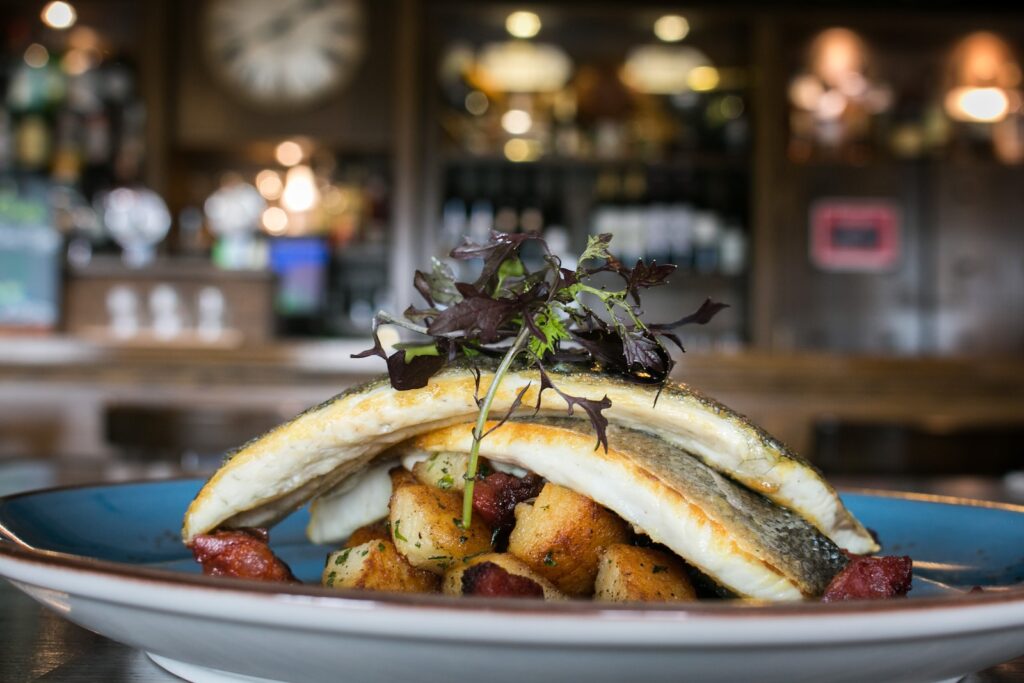Have you ever wondered about the subtle distinctions between “takeaway” and “restaurant” fish and chips? When it comes to this iconic British dish, the difference lies not only in the mode of service but also in the overall experience. Whether you opt for a quick grab-and-go or prefer to savor your meal in a cozy setting, understanding the dissimilarities between these two variations of fish and chips can enhance your culinary exploration.

Table of Contents
Preparation Methods
Frying Technique
When it comes to the preparation methods of fish and chips, one of the key factors that differentiate takeaway fish and chips from restaurant fish and chips is the frying technique employed. In both cases, the fish is coated in batter and deep-fried to achieve that perfectly crispy and golden exterior. However, takeaways often opt for a more traditional and straightforward frying technique, whereas restaurants tend to employ more sophisticated frying methods. This can include the use of specialty fryers or fryer oils that create a unique texture and flavor profile.
Batter
Another crucial element in the preparation of fish and chips is the batter. The batter serves as a protective coating for the fish, keeping it moist and succulent while also providing that desired crunch. Takeaway fish and chips often feature a thicker, more traditional style batter made with a combination of flour, salt, and water. On the other hand, restaurants may offer variations of batter that incorporate additional ingredients such as beer or various spices. These additions can add depth and complexity to the flavor profile of the fish and chips.
Type of Oil
The choice of oil used for frying the fish and chips also contributes to the overall taste and quality of the dish. Takeaways typically use vegetable oil or a blend of vegetable oils due to its affordability and availability. While this choice of oil may still produce delicious results, some restaurants may opt for more specialized oils like peanut oil or beef tallow. These oils have higher smoke points and can enhance the flavor and texture of the fish and chips, giving them a distinctive, professional touch.
Freshness of Ingredients
Fish
Freshness is paramount when it comes to any seafood dish, and fish and chips are no exception. Takeaways and restaurants alike understand the importance of sourcing fresh fish to ensure a delicious and wholesome dining experience. However, a key difference lies in the sourcing and handling practices. Restaurants often establish relationships with local or sustainable seafood suppliers, ensuring that their fish is of the highest quality and ethically sourced. Takeaways, while still prioritizing freshness, may rely on more conventional suppliers or distributors due to cost considerations.
Potatoes
Equally as important as the fish itself is the quality of the potatoes used to make the chips. Takeaways and restaurants alike strive to use the freshest potatoes available to create the perfect crispy exterior and fluffy interior. However, restaurants may take it a step further by hand-cutting their chips or using specific potato varieties known for their exceptional texture and flavor. This attention to detail can elevate the overall taste and dining experience, giving restaurant chips that extra edge.

Portion Size
Fish
When it comes to portion sizes, both takeaways and restaurants offer options to cater to different appetites. However, takeaways typically lean towards larger, more generous portions of fish to satisfy customers looking for a hearty meal. Restaurant portions, on the other hand, may be slightly smaller but often compensate for this by focusing on the presentation and overall dining experience. Regardless of portion size, both options aim to provide a satisfying and filling serving of fish.
Chips
Whether it’s a takeaway or a restaurant, chips (or fries) are a staple accompaniment to fish. Takeaways usually opt for larger portions of chips, ensuring that customers receive a substantial serving of this beloved side dish. However, restaurants may offer more refined presentations of their chips, featuring unique cuts or seasoning techniques that add an extra touch of sophistication to the dish. Ultimately, the size of the chip portion may depend on personal preference and the overall dining experience one seeks.
Presentation
Packaging
The presentation of fish and chips goes beyond the actual food – it extends to the packaging as well. Takeaways often prioritize practicality and convenience by using disposable, easy-to-carry packaging. This allows customers to enjoy their fish and chips wherever they desire, whether it’s at the beach, in the park, or at home. Restaurants, however, focus more on plating the dish in an aesthetically pleasing manner, sometimes using ceramic plates or serving baskets to create a visually appealing presentation. The choice of packaging can enhance the overall experience and determine the setting in which the fish and chips are enjoyed.
Plating
When it comes to plating, restaurants have the advantage of being able to invest more time and effort into creating visually stunning presentations. They often prioritize careful arrangement of the fish, chips, and additional garnishes such as lemon wedges, parsley, or dipping sauces. This attention to detail not only enhances the visual appeal of the dish but also adds to the overall dining experience. Takeaways, while focusing more on efficient packaging, still ensure that the fish and chips are presented in an appetizing manner.

Customization Options
Sauce Varieties
One of the highlights of enjoying fish and chips is the opportunity to customize the dish with a variety of sauces. Takeaways typically offer a wide range of options, including classics such as ketchup, tartar sauce, or malt vinegar. Some may even provide unique homemade sauces or regional specialties to cater to different tastes. Restaurants, while also offering traditional options, may take it a step further by creating their own signature sauces or providing a wider selection of gourmet dipping options. This customization allows individuals to tailor their fish and chips experience according to their personal preferences.
Additional Sides
Aside from various sauce options, both takeaways and restaurants often provide additional sides to complement the fish and chips. Takeaways commonly offer staples such as mushy peas, pickles, or coleslaw, as well as optional extras like onion rings or curry sauce. Restaurants, while offering similar sides, may also provide more refined or unique options to elevate the dining experience. This can include offerings like homemade pickles, specialty salads, or even seafood-based appetizers. The availability of additional sides allows diners to further personalize their meal and explore different taste combinations.
Price
Overall Cost
Pricing is a crucial factor to consider when choosing between a takeaway or a restaurant for your fish and chips fix. Takeaways are often favored for their affordability, providing generous portions at a reasonable price point. This makes them a popular choice for individuals or families seeking a satisfying and economical meal. Restaurants, on the other hand, may have higher price ranges due to factors such as higher quality ingredients, enhanced presentation, and the overall dining experience they provide. While restaurant fish and chips may be pricier, they often offer a level of quality and ambiance that justifies the cost.
Inclusion of Extra Charges
It is essential to note that additional charges may apply when ordering fish and chips, regardless of whether it’s from a takeaway or a restaurant. These charges can vary and may include extras such as additional sauces, sides, or delivery fees if applicable. Takeaways tend to be more transparent with their pricing structures, while restaurants may have added costs for dining in, service charges, or corkage fees for bringing your own beverages. It is always advisable to review the menu or check with the establishment to understand any potential extra charges to avoid surprises when settling the bill.

Availability
Operating Hours
The availability of fish and chips can differ between takeaways and restaurants, particularly when it comes to operating hours. Takeaways often cater to individuals seeking a quick and convenient meal option, operating during lunch and dinner hours and sometimes even staying open late into the night. This allows for a flexible dining experience, whether you’re satisfying a craving or looking for a late-night snack. Restaurants, on the other hand, generally follow more traditional dining hours, opening for lunch and dinner service with specified operating times. This schedule caters to individuals who prefer a sit-down meal within a specific timeframe.
Delivery Options
In today’s fast-paced world, the availability of delivery options can greatly influence the decision between a takeaway and a restaurant for your fish and chips. Takeaways are well-known for their efficient delivery services, allowing customers to enjoy their favorite dish from the comfort of their own home. They often partner with delivery platforms or have their own dedicated delivery team to ensure prompt and hassle-free delivery. While some restaurants offer delivery services as well, it may be more limited due to logistical constraints or the focus on the dine-in experience. Delivery availability can significantly impact the convenience and accessibility of enjoying fish and chips.
Quality Control
Consistency
Consistency in both taste and quality is an important aspect to consider when choosing between a takeaway and a restaurant for your fish and chips. Takeaways often pride themselves on delivering consistent results, ensuring that customers receive the same enjoyable experience each time they order. This reliability can be attributed to standardized recipes, well-established cooking techniques, and the repetition of preparing large quantities of fish and chips. Restaurants, while also striving for consistency, may have more room for variation due to factors such as chef experimentation, daily specials, or seasonal ingredients. It ultimately comes down to personal preference – whether you prefer the familiarity of a consistent takeaway or the element of surprise that comes with a restaurant’s culinary creativity.
Food Safety Standards
Both takeaways and restaurants adhere to strict food safety standards to ensure that the fish and chips they serve are safe to consume. Takeaways are subjected to regular health inspections and must meet basic hygiene requirements. These establishments understand the importance of handling and storing ingredients correctly, as well as maintaining proper cooking temperatures and sanitation practices. Restaurants, however, often have more robust food safety protocols in place due to their larger kitchen spaces and more extensive menus. This can include additional staff training, regular audits, or even certifications from recognized food safety organizations. Regardless of the choice between a takeaway or a restaurant, both prioritize the well-being of their customers by maintaining high food safety standards.
Ambience and Experience
Dine-In Atmosphere
One of the significant advantages of choosing a restaurant for your fish and chips experience is the overall dine-in atmosphere. Restaurants provide a designated space with a specific ambiance and aesthetics, allowing diners to enjoy their meal in a pleasant and often more upscale environment. This can include factors such as comfortable seating, attentive service, and a carefully curated atmosphere. A dine-in experience at a restaurant offers an opportunity to savor the fish and chips amidst an ambiance that enhances the enjoyment of the meal.
Takeaway Convenience
While restaurants excel in providing a refined dine-in experience, takeaways offer a different kind of convenience. Choosing a takeaway for your fish and chips allows you to enjoy them in the comfort of your own home or any location that suits your preference. Takeaways optimize for convenience and quick service, ensuring that your order is prepared promptly and delivered efficiently. This convenience factor makes takeaways a popular choice for individuals on the go, those craving a cozy night in, or a gathering with family and friends at a venue of their choice.
Reputation and Trust
Customer Reviews
When it comes to deciding between a takeaway and a restaurant for your fish and chips, customer reviews can play a vital role in building trust and influencing your choice. Takeaways and restaurants alike can be reviewed and rated by customers on various platforms, providing insights into the quality of their food, service, and overall experience. Checking online reviews can give you an idea of what to expect from a specific establishment and help you make an informed decision based on the experiences of others.
Established History
Established history and reputation can also influence your decision between a takeaway and a restaurant. Takeaways that have been serving fish and chips for generations in a local community often carry a sense of tradition and trust. These longstanding establishments have built a loyal customer base through their consistently delicious offerings. Restaurants with a well-established presence and reputation also bring a level of confidence due to their commitment to quality and delivering memorable dining experiences. Considering the history and reputation of an establishment can help instill trust and assurance in your choice of where to enjoy your fish and chips.
Conclusion
In conclusion, whether you opt for a takeaway or a restaurant for your fish and chips, both options offer their own unique advantages. Takeaways provide a convenient, affordable, and consistently satisfying experience, often favored for their larger portions and practical packaging. On the other hand, restaurants offer a more refined and immersive dining experience, with attention to detail in the presentation, ambiance, and overall quality. Factors such as customization options, additional sides, and the availability of delivery can also influence your decision. Ultimately, the choice between a takeaway and a restaurant for your fish and chips depends on your personal preferences, the occasion, and the dining experience you desire.
